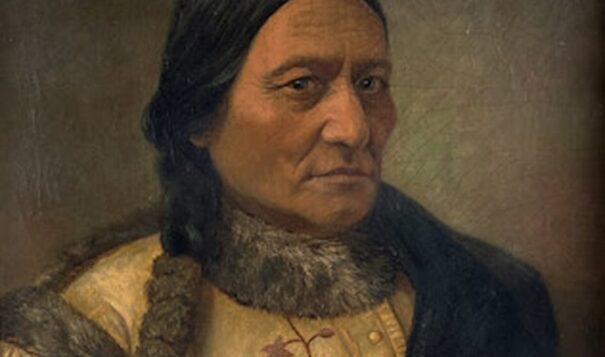Behind the Story Clarifies for the public how a story was reported.
Sitting Bull portrait sells at auction to private bidder
 This 1890 painting of Sitting Bull by artist Catherine Weldon sold at auction on March 18, 2023, for $67,000 at Blackwell Auctions in Clearwater, Florida. Weldon's friendship with Sitting Bull in the late 1880s was told, with some embellishment, in the 2017 film, "Woman Walks Ahead," starring Jessica Chastain as Weldon and Michael Greyeyes as Sitting Bull. (Photo courtesy of Blackwell Auctions)
This 1890 painting of Sitting Bull by artist Catherine Weldon sold at auction on March 18, 2023, for $67,000 at Blackwell Auctions in Clearwater, Florida. Weldon's friendship with Sitting Bull in the late 1880s was told, with some embellishment, in the 2017 film, "Woman Walks Ahead," starring Jessica Chastain as Weldon and Michael Greyeyes as Sitting Bull. (Photo courtesy of Blackwell Auctions)
The rare 1890 painting by a New York artist and activist was sold by an heir to the original buyer
The rare portrait of Lakota leader Sitting Bull (1831-1890) that was up for sale at Blackwell Auctions sold for $67,100 on March 18 to a private purchaser from the northeastern United States.
The portrait was one of four paintings of Sitting Bull created by New York artist and activist Caroline Weldon, and is thought to be the only one that was still in private hands.
Stored for decades and needing repair, the solemn portrait of the charismatic Lakota leader was consigned to auction by heirs of the original owner from 1890. The artist’s friendship with Sitting Bull was made into a 2017 film, “Woman Walks Ahead.”
“I just tried to promote it as best I could,” Blackwell auctioneer Edwin Bailey told ICT. “I knew that it was a very special piece, and the story was absolutely fascinating. The deeper I got into it, I watched the movie and contacted the historical researchers.”
Bailey said the painting was special because it is “vastly superior to the other two Weldon painted. The value of the painting was based on its subject matter and its dramatic history, not the popularity of the artist or broad demand for the artist’s work, which is usually what drives the value of a piece of art.”
Daniel Guggisberg, historian and researcher, told ICT that the portrait was not done from a sitting, one of several revisions to the story that was portrayed in the 2017 film featuring Jessica Chastain as Weldon and Michael Greyeyes as Sitting Bull.
“It is based on a portrait made by photographers Palmquist & Jurgens of Minneapolis in March 1884,” Guggisberg said.. “The other two known paintings of Sitting Bull she made are based on photographs, notably by William Notman & Son of Montreal, taken in August 1885 while Sitting Bull toured with Buffalo Bill’s Wild West. She did not paint from life – would not have the means to do so and Sitting Bull certainly would not have agreed to sit for a painted portrait for hours or days on end. Caroline Weldon certainly had artistic talent, but not beyond an amateur’s level.”
Weldon went to see Sitting Bull in the late 1880s to help him politically, not to paint him. She ended up staying and moving into his camp at the Standing Rock Reservation with his family.
Guggisberg said that “the painting presumably was made while Caroline Weldon had briefly returned to Brooklyn in the latter part of 1889 and early 1890. The date on the painting is 1890.”
Weldon is believed to have sold the painting to the man who’s heirs recently put it up for auction.
“As far as I know, no painting by Carolyn Weldon has ever sold at auction,” Guggisberg said. “While the story in the film was greatly changed, even without the motion picture, I still think this would’ve been an amazing piece because of the story.”
Bailey said Weldon endured a lot of heat — even physical violence — for promoting Native rights in the late 1800s.
Bailey said he started the bids on March 18 at $20,000 and said the final sales figure was reached in about two minutes.
“It didn’t have any bids on it to start with, advanced bids, pre-op option bids,” he said. “There were several people that just got on when the option started, and it ran to where it ran. That’s one of those pieces that could have gone anywhere. “
Bailey said the seller is granddaughter of William Lafayette Darling, a railroad engineer from St. Paul that was involved in the construction of the Northern Pacific Line at the time that went through the Dakotas on to Montana and Idaho. He is believed to have purchased the painting from Weldon. When he died in 1938, the the painting went to his daughter and then to her daughter in 1990.
The painting will soon be shipped to the new owner.
“We’ve been in touch with the buyer, and it’s been hanging up here on the wall for several weeks now,” he said. “I’m looking at it right now.”
Bailey said the auction house does not release details about the buyer.
“I can say that they’re in the Northeast, and I hope they loan or exhibit it,” he said. “It’s not something I can even fathom somebody just poking down a hallway and looking at once in a while. I just don’t see that happening. I think it’s going to show up again, and I think it’s going to show up at a museum, perhaps by a private collector. The best I’ll say is that is what I hope is the outcome.”
